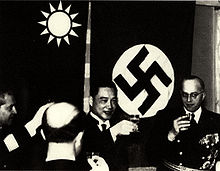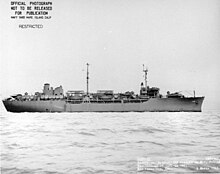Heinrich Georg Stahmer


Heinrich Georg Stahmer (born May 3, 1892 in Hamburg , † June 13, 1978 in Vaduz ) was a National Socialist German diplomat who was promoted from the Ribbentrop department to the Foreign Service and became ambassador in Nanjing and Tokyo .
biography
Heinrich Georg Stahmer came from a Hamburg merchant family. As a cavalry officer, he joined the air force during the First World War in the spring of 1915 and was highly decorated. After the war he first went on a study trip to Central and South America from 1919 to 1920. "After his return he found use in German industry, where he was most recently a board member in various companies".
After the handover of power to the National Socialists , he joined the Ribbentrop office in 1934 , where he controlled the international contacts of the front-line fighter organizations from 1935 onwards as the "staff leader of the German front-line fighter associations". He was involved in organizing the war veterans' meeting in Verdun for the twentieth anniversary. The "Franco-German Society" was controlled by Ribbentrop by launching Otto Abetz into the position of Deputy Chairman and Stahmer into the Treasurer's position. He initially took over the “Main Section South America” and then the “Main Section Far East”, where he began with cultural exchange between Japan and Germany. Stahmer was a member of the NSDAP (membership number 867.525), as a member of the Ribbentrop office, as Otto Abetz claimed for all office employees , he was a member of the SS (membership number 257.091), this also in his function as "Referent für Übersee" in the Volksdeutschen Mittelstelle , an SS main office.
In 1938 he was awarded the Commander's Cross with a Star of the Princely Liechtenstein Order of Merit . In 1939 he was raised to the hereditary baron status and to the personal count status as Count von Silum . His full name was now Heinrich Georg Freiherr von Stahmer, Count of Silum.
Stahmer accompanied the National Socialist Carl Eduard Herzog von Sachsen-Coburg and Gotha , President of the German Red Cross and President of the National Socialist German Front Fighter League , on a trip to Japan and the USA from autumn 1939 to spring 1940; Stahmer received the for this trip beforehand Rank of "Consul General".
On August 13, 1940, Stahmer, now "envoy", was Ribbentrop's special representative for negotiations with Japan. Stahmer and Ambassador Eugen Ott negotiated with Foreign Minister Matsuoka in Tokyo from September 6 to 25, 1940 . In order not to endanger Ribbentrop's propaganda success, Ott and Stahmer signed additional secret protocols without the official knowledge of the German government. In addition, Stahmer wrote a letter, without having been authorized to do so, in which he expressed his view that Germany would leave the former colony of German New Guinea to Japan in return for compensation . However, Stahmer passed the actual success of the negotiations on to Ambassador Ott, who also received the larger Japanese medal. After the three-power Germany-Italy-Japan pact was signed in Berlin on September 27, 1940, Stahmer was given the official title of “Ambassador for Special Use” at the end of November 1940 in recognition of the successful negotiations for the accession of Japan.
From January 9, 1942 to the end of 1942, Stahmer was the ambassador of the German Reich to the national Chinese government in Nanjing . His successor there on July 27, 1943 was Ernst Woermann . On January 30, 1943, Stahmer took over the business of the German Embassy in Tokyo as ambassador, replacing Eugen Ott, who had fallen as a result of the espionage affair surrounding the spy Richard Sorge . The naval attaché at the embassy in Tokyo, Admiral Paul Wenneker, however, considered Stahmer to be completely unsuitable as head of the embassy, a large authority, and accused him of being in the hands of SS-Standartenführer Josef Meisinger . It is possible that Stahmer was unable to defend himself because he had a "non-Aryan" wife, and the ambassador's inaction in the Ivar Lissner case was later seen in this light.
In May 1945 he was interned by the Japanese. On September 10, 1945, he was interned in the United States and initially imprisoned with Japanese politicians and the military in Sugamo Prison . Among other things, Stahmer was interrogated by the Americans about the formation of the Three Power Pact. In the Tokyo trials , he had to testify as a witness in court. In September 1947, he and his wife started their return journey to Germany on a troop transport ship together with other deportees. He was interned in Germany until the end of September 1948.
Nothing is known about his denazification in Germany. Count von Stahmer-Silum moved to Vaduz and worked there as a merchant. Der Spiegel quoted him in 1951 in the public discussion about the fate of Richard Sorges. Stahmer published a book on the Far East under "HG Stahmer" in the summer of 1952 , which contained "no memoirs in the common sense". In the fall of 1952 he made a trip to Japan as an export merchant.
Fonts
- Germany and Japan , in: The XXth Century , Feb. 1943 (English-language newspaper in Shanghai) Available online (PDF; 600 kB) as "Heinrich Stahmer".
- Japan's defeat - Asia's victory: Rise of a Greater East Asia , Bielefeld: Deutscher Heimat-Verlag, Bielefeld 1952.
literature
- Biographical manual of the German Foreign Service 1871–1945. Volume 4: p . Published by the Foreign Office, Historical Service, edited by: Bernd Isphording, Gerhard Keiper, Martin Kröger. Schöningh, Paderborn et al. 2012, ISBN 978-3-506-71843-3 , p. 319f
- Heinrich Georg Stahmer , Internationales Biographisches Archiv 01/1953 of December 22, 1952, in the Munzinger Archive ( beginning of article freely available)
- Peter Geiger, article "Stahmer, Heinrich Georg" in: Historical Lexicon for the Principality of Liechtenstein , publisher Liechtenstein Institute (not yet consulted)
- Hans Schwalbe, Heinrich Seemann (Ed.): German Ambassador to Japan 1860–1973 . Tokyo: Dt. Ges. For natural u. Ethnology of East Asia. Announcements of the German Society for Natural and Ethnographic East Asia; Vol. 57 1974. DNB (not yet consulted)
- Editor HLFL: Stahmer, Heinrich Georg Freiherr von, Count von Silum. In: Historical Lexicon of the Principality of Liechtenstein .
Individual evidence
- ^ Munzinger archive
- ^ Roland Ray: Approaching France in the service of Hitler? Otto Abetz and the German policy on France 1930-1942. Munich 2000, ISBN 3-486-56495-1 , p. 144
- ^ Roland Ray: Approaching France , p. 176
- ^ "Germany and Japan" The XXth Century , Feb. 1943
- ↑ The time of joining the party is not known, in the 1941 photograph he wears the party badge on his order's breast
- ↑ Roland Ray: Approaching France , reference to p. 125, note 72
- ^ Entry on Heinrich Georg Stahmer on www.e-archiv.li
- ^ Erich Kordt , Wahn undreality (with co-author Karl Heinz Abshagen ), Stuttgart: Union 1947, p. 258; HGStahmer, Japan's defeat p. 21
- ↑ Johanna M. Menzel, The Secret German-Japanese Exchange of Notes on the Three Power Pact , in: Vierteljahrshefte für Zeitgeschichte, issue 2, 1957 [1] (PDF; 4.6 MB)
- ↑ Erich Kordt, Wahn undreality , p. 317
- ↑ MR. SORGE SAT AT THE TABLE OF SPIEGEL 35/1951 . During his denazification process, however, Ott no longer wanted to hear anything about his belligerent successes and activities.
- ↑ Clemens Jochem: The Foerster case: The German-Japanese machine factory in Tokyo and the Jewish auxiliary committee Hentrich and Hentrich, Berlin 2017, p. 220 f., Note 95, ISBN 978-3-95565-225-8 .
- ^ Paul Werner Wenneker, report on the stays in Japan, German marine archives
- ↑ Code name Ivar DER SPIEGEL 51/1970 .
- ↑ z. B. Interrogation on March 8, 1946, Menzel, The secret German-Japanese exchange of notes , p. 187
- ↑ see photo Stahmer in the witness stand in: HGStahmer, Japans Deflage, plate VIII
- ↑ HGStahmer, Japan's defeat p.194
- ↑ The article from the Historical Lexicon for the Principality of Liechtenstein has not yet been used
- ↑ MR. SORGE SAT AT THE TABLE OF SPIEGEL 40/1951 . In his book, too, Stahmer speculates that the worry he despises is still alive (p. 86).
- ↑ HGStahmer, Japan's defeat p. 7
| personal data | |
|---|---|
| SURNAME | Stahmer, Heinrich Georg |
| BRIEF DESCRIPTION | National Socialist German diplomat |
| DATE OF BIRTH | May 3, 1892 |
| PLACE OF BIRTH | Hamburg |
| DATE OF DEATH | June 13, 1978 |
| Place of death | Vaduz |
